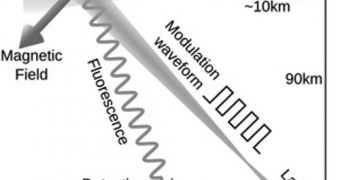A team of physicists at the University of California in Berkeley (UCB) announces the development of a new method of mapping the planet's magnetic field. Their approach does not rely on the use of expensive satellites or other orbit-based surveillance systems.
Analyzing Earth's magnetic field is tremendously important, planetary scientists say. Data collected from such studies can be used to look deep under the crust, or even to track powerful storms.
But such an effort typically requires expensive satellites, and the current economic climate does not allow for such capabilities to be readily deployed. As such, experts had to come up with a new means of conducting their investigations.
The UCB group was able to do so using only a ground-based laser, which is aimed at a layer of sodium atoms located high in the atmosphere, at altitudes of about 90 kilometers (60 miles).
After the laser pulses excite these atoms, a telescope observes the light they emit. “Normally, the laser makes the sodium atom fluoresce,” explains UCB professor of physics Dmitry Budker, the leader of the research team that developed the new technique.
“But if you modulate the laser light, when the modulation frequency matches the spin precession of the sodium atoms, the brightness of the spot changes,” the expert explains.
The reason why these atoms are targeted is because the local magnetic field determines the frequency at which they precess. As such, using the new study method from any location on Earth will help scientists determine the properties of the planet's magnetic field at those locations.
Details of the new investigation appear in this week's online issue of the esteemed journal Proceedings of the National Academy of Sciences (PNAS). The work was carried out in collaboration with scientists from the European Southern Observatory (ESO).
“A ground-based remote sensing system allows you to measure when and where you want and avoids problems of spatial and temporal dependence caused by satellite movement,” Budker explains.
“Initially, this is going to be competitive with the best satellite measurements, but it could be improved drastically,” he goes on to say.
The expert believes that a single, 20- to 50-watt laser could be sufficient for magnetic field analysis. Such a device would be small enough to fit on a truck or small boat. In order to operate properly, it would need to be tuned to a wavelength of 589 nanometers, at the orange sodium line.

 14 DAY TRIAL //
14 DAY TRIAL //